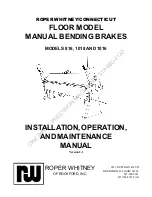
The clamping handles at each end of the brake are wrapped and wired in the down
position to prevent damage and to prevent the handles from being used to move
the brake. Remove the wires and wrapping.
Wooden blocks are positioned between the upper and lower beam jaws to prevent
damage during shipment. Lift the clamping handles and remove the blocks.
The bending leaf (apron), is wired to the center truss stud of the lower beam to
prevent movement during transit. Remove the wire.
Remove the four (4) carriage bolts, nuts, and washers securing the brake to the
skidding.
DO NOT REMOVE THE BRAKE FROM THE SKID AT THIS
TIME.
Manual Brake Installation, Operation, and Maintenance Manual
Page 6
WARNING AND CAUTION
SERIOUS INJURY CAN RESULT OR THE BENDING BRAKE CAN BE
DAMAGED
Do not operate the brake on the skid. The brake must be attached to the floor. The
machine is topheavy and can tip if not securely anchored. The skid does not provide
a suitable anchoring platform.
SITE
PREPARATION
The brake must be placed on a firm floor which does not sag and which does not
have any "spring" to it. The floor must be generally level, with no twisting or
unevenness in the surface. The floor must also be capable of accepting 1/2-inch lag
screws or bolts for the purpose of securing the brake.
There must be adequate area around the brake for free movement of the operator
and the handling of large sheets of metal. Allow 4 to 6 feet behind the brake, 6 to
8 feet in front of the brake, and 3 feet on either end of the brake.
To move the brake off the skid, and to its mounting position, use an overhead crane
or a fork lift with the forks above the brake. If a fork lift is used, secure a lifting
hook on the lift forks. Pass a sling under brake and secure each end on the lifting
hook as shown in Figure 2.
CAUTION
THE BENDING BRAKE CAN BE DAMAGED
Do not move the brake using lift truck forks directly under any machine members.
Содержание 1016
Страница 2: ......













































